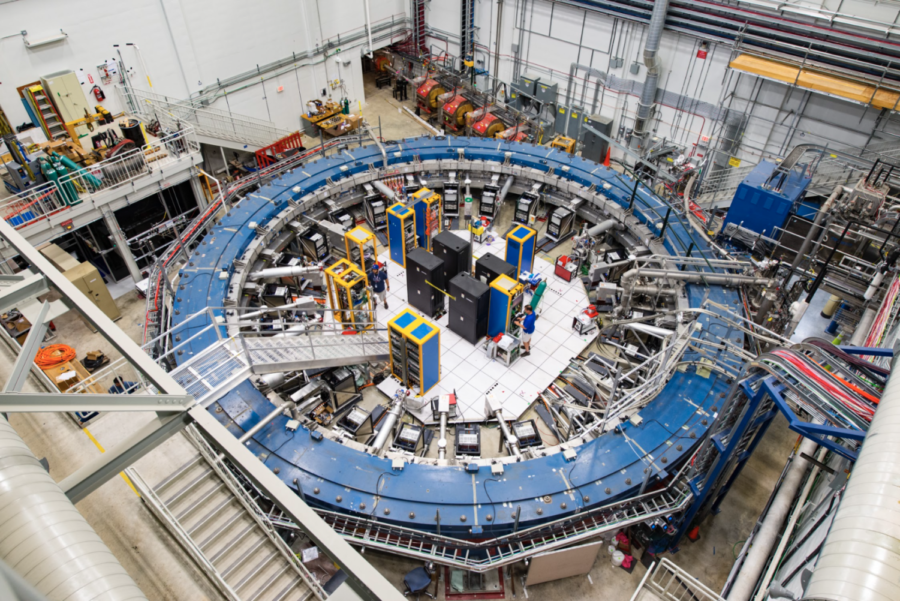Kentucky researchers play role in groundbreaking physics experiment
The Muon g-2 ring sits in its detector hall amidst electronics racks and the muon beamline. This experiment studies the precession (or wobble) of muons as they travel through the magnetic field.
April 20, 2021
A landmark study conducted through the U.S. Department of Energy’s Fermilab has proven that some fundamental particles do not obey the known laws of physics, what scientists call the Standard Model.
These particles, known as muons, may be acted upon by an unknown force like another undiscovered particle. Simulations run at Fermilab and at UK’s own supercomputer support this idea, first indicated by a previous experiment at Brookhaven Laboratory. Early studies showed that the speed of muons, which occur when cosmic rays hit Earth’s atmosphere, is slightly off from what the Standard Model would predict, leading to a ‘wobble.’
“Turns out there’s been signs in the past that the theory cannot predict the correct number. So, what that means is that there’s possibly forces and/or particles that are not in the theory,” said Dr. Renee Fatemi, a professor of physics at UK and co-lead investigator of the Fermilab experiment.
Fatemi is one of a team of researchers at the university who contributed to the study, including several postdocs and graduate students.
“We have four graduate students. Two of them are women. One of them is Hispanic. And one is from China. And my postdoc is a woman as well,” Fatemi said. Members of the UK team helped analyze the data from the experiment, which first began simulations in 2018. According to a release from Fermilab, only 6 percent of the planned data has been analyzed so far as researchers are currently analyzing numbers from the second and third runs of the muon g-2 ring, with a fourth run underway and a fifth planned.
Still, the initial numbers show strong evidence of a new phenomenon in physics, though falling just short of the significance threshold to claim a discovery.
“This is interesting because it turns out that you can do this experiment, but you can also calculate what the value should be in theory, and you can calculate it to the same precision as you can measure it,” Fatemi said.
Fatemi was the simulations manager for the Muon g-2 experiment, which was primarily conducted in a 50-foot-diameter superconducting magnetic ring through which muons are beamed. As the muons, which are similar to an electron but about 200 times heavier, circulate in the particle accelerator, they interact with other subatomic particles in a “quantum foam.” Fatemi’s team studies the decay of muons and is able to determine their magnetic properties based on their decay when put in magnetic fields.
Though particle accelerators can calculate this to an extremely precise level, the numbers on muons’ g-factor – the rate at which forces cause muons to wobble – were not adding up, and Fatemi’s team saw that. The difference led the physicists behind the g-2 experiment to conclude that there is more matter out there than the field of science currently accounts for.
Fatemi’s team includes Brad Plaster and Tim Gorringe, among many others. They started the experiment back in 2014, but these are the first results released. Fatemi said the “unblinding” or reveal of the final number that pointed to the significance of this study was announced to them on Feb. 25.
Beyond being a part of this experiment, Fatemi was excited to work alongside a very diverse team of individuals.
“We did this amazing experiment. And we did it with all these underrepresented minorities,” Fatemi said. As simulations manager, she developed some of the systems allowing the simulator to interpret the data.
Fatemi explained that theorists are coming up with ideas about what is causing the difference they are seeing in this experiment. She said that it is currently theorized that this could be due to supersymmetry, or SUSY, particles that they have not yet discovered.
SUSY expands the current Standard Model, explaining additional symmetry and pairing between particles. Another theory is that the difference could be caused by dark matter.
“I think what we have to do is rely on our theory friends. They develop new models of what could be explaining it, and it’s their job to sort of figure out if their model fits in with this data,” Fatemi said.




















































































































































